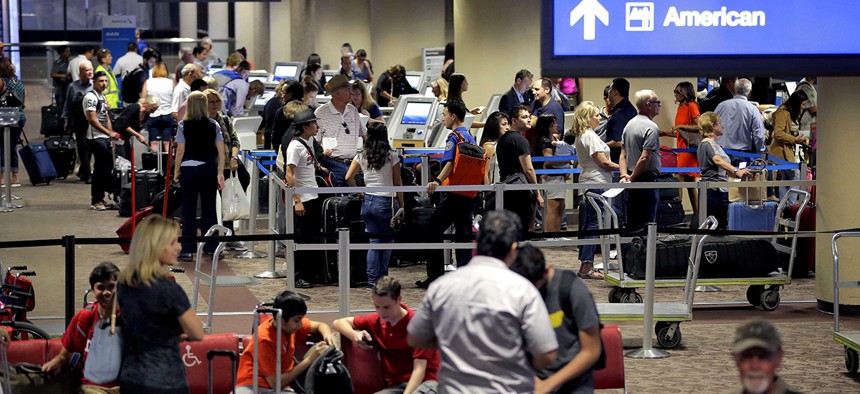An App Could Soon Tell Airport Agents if Travelers Might be Lying

Passengers line up to check in before their flight at Sky Harbor International Airport in Phoenix. Matt York/AP File Photo
Customs and Border Protection wants startups' help updating the airport process.
Frustrated with wait times at airports?
So is Customs and Border Protection -- so much that it wants an app that could conduct the airport security interview process over passengers’ personal smartphones.
The Homeland Security Department wants startups, especially in the Silicon Valley area, to contribute technology that could “remotely conduct interviews and verify traveler identity” -- even to the point of detecting if the traveler is lying, according to a FedBizOpps post.
DHS is hosting an industry day in Menlo Park, California, later this month on the topic, in conjunction with an event on a related search for drone technology CBP officers could use to aerially monitor borders.
In one hypothetical scenario DHS presents to potential contractors, travelers entering the United States might download an app on their smartphone or tablet that would let them verify their identity, transmit biometric data such as fingerprints and biometric scans, and allow the CBP officer to interview the traveler via video chat. A traveler might be able to finish this process before he or she gets to the inspection area, according to DHS’ posting.
» Get the best federal technology news and ideas delivered right to your inbox. Sign up here.
Broadly, DHS wants technology “that increase[s] security while reducing processing time,” and also “quickly, accurately and reliably” identifies foreign nationals. These systems could let CBP officers screen “without the need for both officer and the traveler to be physically present at the same facility."
Specifically, Homeland Security wants features including:
- A system to review and scan travel documents such as passports and visas, equipped with “fraudulent document detection”
- Technology that can help officers establish a traveler’s “purpose and intent” using an “automated behavioral analysis tool” that would flag deceptive behavior, such as changes in heart rate
- Biometric data collection
- Mobility so it could potentially be used at seaports or outdoors
- An intuitive interface for officers and travelers
New solutions could use CBP’s existing infrastructure -- interview booths, video call stations, but also rely on other devices such as passengers’ electronic devices, DHS wrote.
CBP’s job is affected by airport size, flight schedule, weather and other factors, so these new solutions would need to withstand increased passenger volume. The agency processes more than 300,000 passengers daily across the U.S., according to DHS.





